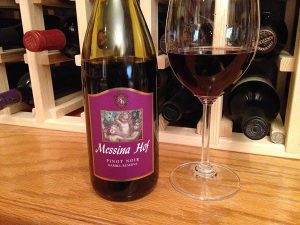Château Calon-Ségur Marquis de Calon Saint-Estèphe 2009: Second label of Medoc’s northernmost classified growth by maker that has roots back to the 12th century. This vintage has 53% cab, 38% merlot, 7% cab franc and 2% petit verdot—other vintages tilt toward merlot. Very serious wine that also is very approachable introduction to the great wines of Bordeaux. Superb velvety richness, depth, with minerality generated by vines growing in gravel beds that are 16-feet deep, earth, balancing acidity; dark cherry, some spice box, wisp of vanilla. Elegant depth and length are the dominant characteristics, the wine just keeps on deliciously performing in your mouth even after you fully swallow. $42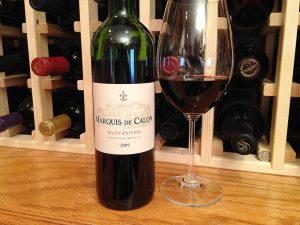
Month: July 2015
Trinity Hill The Trinity Hawkes Bay 2013
Trinity Hill The Trinity Hawkes Bay 2013: Merlot, tempranillo, malbec and smattering of other varietals make for flavors from all directions; merlot plum and leather; tempranillo red fruit, blackberry, spice; malbec’s twist on blackberry, plum; thin layer of oak, soft mouth; light, ripe tannin; medium acidity, smooth. Grape mix depends on vintage (merlot is the standard lead in the blend each year, however), so flavor profile will vary year-to-year with this solid New Zealand easy-drinking effort. Hawkes Bay (east coast of the north island) is one of NZ’s oldest, most-established wine districts. Hawkes Bay label is Trinity’s consumer-priced offering. $20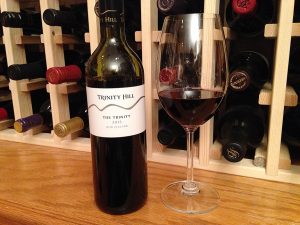
Kermit Lynch Côtes du Rhône 2013
Kermit Lynch Côtes du Rhône 2013: This is consistent value from premier American wine importer, wine writer, and negociant (a wine merchant who buys grapes, partially fermented juice, or finished wine and sells the finished bottles under his own name). Lynch knocked negociants in his early years, then saw the light; American wine drinkers are the better for it. This vintage presents the black cherry, blackberry, raspberry expected from a grenache-led blend; syrah, carignan, cinsault, mourvèdre are here, too, so choose your favorite red grape flavor and you probably can find at least a hint in your glass. Smooth, well-rounded; approachable tannin, some acidity; easy to enjoy at the price. $14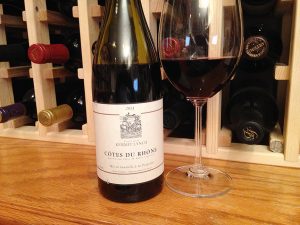
Toschi Vineyards Riesling 2013
Toschi Vineyards Riesling 2013: Peach, citrus, apricot, spice; balanced, medium dry, acceptable acidity; straightforward, easy drinker; will go well with many foods; enough sweetness to please those who dread dry, enough restraint to not offend those who prefer dry. Toschi is winemaker in San Joaquin Valley, which is by far the largest producing region in the United States—it is 220 miles long and 40-60 miles wide. San Joaquin region has more than 150,000 grape-growing acres (French Colombard is most-grown grape with 28,000 acres, followed by chardonnay with 16,000; zinfandel is most-grown red with 14,000 acres); almost half of California grape crush comes from the San Joaquin Valley; if you eat raisins or drink boxed wine, it likely came from here. Toschi aims for little higher quality and achieves. $9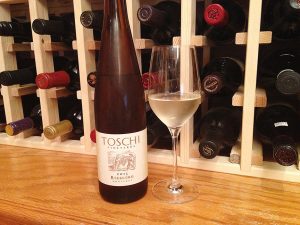
Alamos Malbec Mendoza 2013
Alamos Malbec Mendoza 2013: Plenty of plum, some blackberry from 90% malbec grapes, twist of pepper and dark cherry from 6% syrah, hint of blackcurrant tang from 4% bonarda; bold, but smooth easy drinker with refined tannin, toasty oak that is not overdone, balancing acidity, chip of chocolate on the finish. Medium body, balanced, tasty; classic affordable malbec from famously dependable maker. Mendoza wine region accounts for two-thirds of Argentina’s wine production; it is semi-arid desert (eight-inch annual rainfall), so vines are irrigated with meltwater from Andes to the west; some of the water is delivered by canals dating from the 1500s. With vineyard elevations ranging from 1,000 to 5,000 feet, Mendoza is one of the world’s enchanting, magical wine regions. $13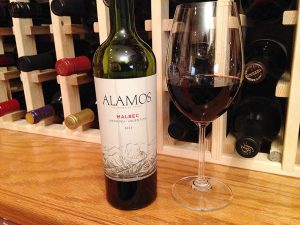
Château Sénéjac Cru Bourgeois Haut-Médoc 2010
Château Sénéjac Cru Bourgeois Haut-Médoc 2010: Solid, friendly over-achiever; cherry, raspberry, layers of black fruit, blackcurrant tingle, white chocolate; extra dry, firm but well-behaved tannin, acidity, long velvety finish. Blend is 48% cab, 37% merlot, finished with cab franc and petit verdot. Cru Bourgeois is classification of Médoc wines that were not included in the famous 1855 Classification; it dates from 1932 and is awarded annually as a mark of quality, making Cru Bourgeois a happy hunting ground for superb Bordeaux at affordable prices. Médoc is a left bank region of Bordeaux that includes the mouth of Gironde estuary in the north and the Atlantic in the west. It is often called the most famous wine region in the word, and certainly is the most famous red wine region in Bordeaux. Château Sénéjac’s effort offers you a first-tier taste at affordable price. The fact that 2010 was excellent vintage adds to the delight. $30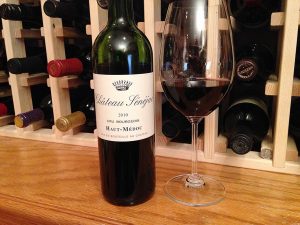
Château La Tour de Bessan Cru Bourgeois Margaux 2010
Château La Tour de Bessan Cru Bourgeois Margaux 2010: Delightful floral nose; plum, blackberry, blackcurrant tang, black tea, minerality, smoke; oak toast, vanilla and spice from 18 months in French oak barrels; firm body, silky texture; 64% cab, 33% merlot, 3% cab franc; slightly rustic with intense-but-integrated tannin, good acidity, long finish. Margaux is southern appellation of the Médoc and has the most gravely soil (the next region south is named for gravel—Graves), which forces vines to put down deep roots and gives Margaux wines their mineral notes. Margaux may produce the most outstanding wines in the Médoc in good vintages and struggle the most in difficult years. Fortunately, 2010 was excellent year, as this wine demonstrates at a great price. Like most Bordeaux reds, this significantly benefits from decanting. $27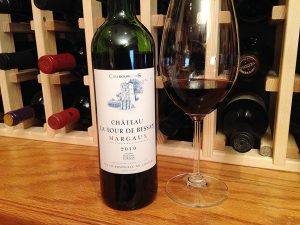
The Prisoner Wine Company Napa Valley The Prisoner 2013
The Prisoner Wine Company Napa Valley The Prisoner 2013. Flamboyantly fruity; dark cherry, espresso, pepper, blackcurrant tang, blueberry, figs, raspberry, pomegranate, licorice; big, bold, rich, lush, decidedly New World blend led by 44% zin, followed by 20% cab, 16% petite sirah, plus some syrah, grenache, and charbono. With that mix, you gotta find something to like. Throw in some big oak just in case—a cord of oak lathered over the entire fruit assault. Tight tannin, but smooth, fruity sweet, some acidity, opulent verging on decadent with whopping 15.2 alcohol. This prisoner screams Left Coast party, party, party. $42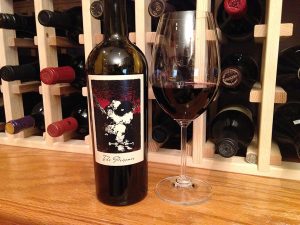
Tom Gore Vineyards Alexander Valley Field Blend 2012
Tom Gore Vineyards Alexander Valley Field Blend 2012: Lush, robust, complex, fruit-forward; midnight black color with faintest hint of dark ruby edge; blackberry, leather, dark cherry, subdued blackcurrant tanginess; smooth, easy drinker with firm, pleasant tannin, acidity. Traditional “field blend” meant varieties were planted and harvested together and you got whatever you got. Since different grapes mature at different times, in most cases today “field blend” means the same as blend—the varieties came for distinct acres and were blended in the winery. Sometimes different varieties are fermented together (co-fermentation), but most often the blending occurs after fermentation. Tom Gore does not state how the 35% petit verdot, 33% malbec, 21% merlot, 6% cab, 5% tempranillo were brought together, but given the quality of this wine, it is likely wines were blended after fermentation to achieve this level of delicious richness. $40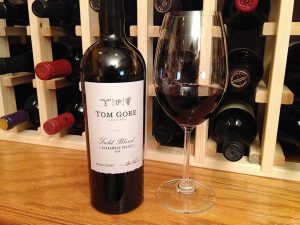
Messina Hof Pinot Noir Barrel Reserve NV
Messina Hof Pinot Noir Barrel Reserve NV: Rich, jammy, sweet fruit-forward, load of ripe plum and cherry; Lodi value style rather than Washington State or Oregon; grapes come from Messina Hof’s vineyards near Bryan, Texas. Medium body, load of oak, smooth, built for supermarket sale rather than reaching for etherial delights pinot noir can attain with less oak and less over-ripe fruit. Messina Hof prides itself on having a very large portfolio of wines, and this checks off one of the categories. “Barrel Reserve” is an empty wine label term that has no official meaning, here it is fluff title for Messina Hof’s second-tier, value-priced pinot. If you are an Apothic Red, Yellow Tail fan, this will please you. $14